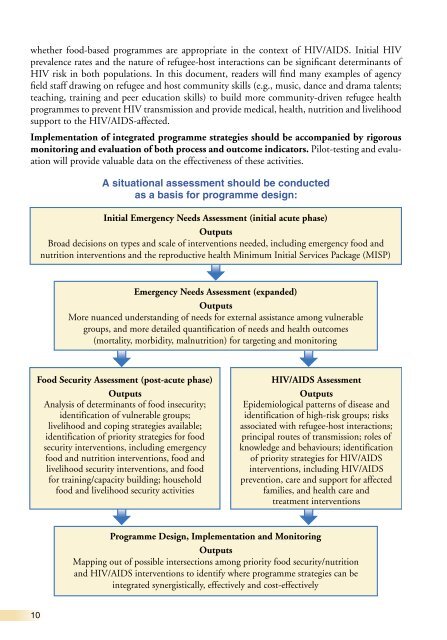Integration of HIV/AIDS activities with food and nutrition support in ...
Integration of HIV/AIDS activities with food and nutrition support in ...
Integration of HIV/AIDS activities with food and nutrition support in ...
You also want an ePaper? Increase the reach of your titles
YUMPU automatically turns print PDFs into web optimized ePapers that Google loves.
whether <strong>food</strong>-based programmes are appropriate <strong>in</strong> the context <strong>of</strong> <strong>HIV</strong>/<strong>AIDS</strong>. Initial <strong>HIV</strong><br />
prevalence rates <strong>and</strong> the nature <strong>of</strong> refugee-host <strong>in</strong>teractions can be significant determ<strong>in</strong>ants <strong>of</strong><br />
<strong>HIV</strong> risk <strong>in</strong> both populations. In this document, readers will f<strong>in</strong>d many examples <strong>of</strong> agency<br />
field staff draw<strong>in</strong>g on refugee <strong>and</strong> host community skills (e.g., music, dance <strong>and</strong> drama talents;<br />
teach<strong>in</strong>g, tra<strong>in</strong><strong>in</strong>g <strong>and</strong> peer education skills) to build more community-driven refugee health<br />
programmes to prevent <strong>HIV</strong> transmission <strong>and</strong> provide medical, health, <strong>nutrition</strong> <strong>and</strong> livelihood<br />
<strong>support</strong> to the <strong>HIV</strong>/<strong>AIDS</strong>-affected.<br />
Implementation <strong>of</strong> <strong>in</strong>tegrated programme strategies should be accompanied by rigorous<br />
monitor<strong>in</strong>g <strong>and</strong> evaluation <strong>of</strong> both process <strong>and</strong> outcome <strong>in</strong>dicators. Pilot-test<strong>in</strong>g <strong>and</strong> evaluation<br />
will provide valuable data on the effectiveness <strong>of</strong> these <strong>activities</strong>.<br />
10<br />
A situational assessment should be conducted<br />
as a basis for programme design:<br />
Initial Emergency Needs Assessment (<strong>in</strong>itial acute phase)<br />
Outputs<br />
Broad decisions on types <strong>and</strong> scale <strong>of</strong> <strong>in</strong>terventions needed, <strong>in</strong>clud<strong>in</strong>g emergency <strong>food</strong> <strong>and</strong><br />
<strong>nutrition</strong> <strong>in</strong>terventions <strong>and</strong> the reproductive health M<strong>in</strong>imum Initial Services Package (MISP)<br />
Emergency Needs Assessment (exp<strong>and</strong>ed)<br />
Outputs<br />
More nuanced underst<strong>and</strong><strong>in</strong>g <strong>of</strong> needs for external assistance among vulnerable<br />
groups, <strong>and</strong> more detailed quantification <strong>of</strong> needs <strong>and</strong> health outcomes<br />
(mortality, morbidity, mal<strong>nutrition</strong>) for target<strong>in</strong>g <strong>and</strong> monitor<strong>in</strong>g<br />
Food Security Assessment (post-acute phase)<br />
Outputs<br />
Analysis <strong>of</strong> determ<strong>in</strong>ants <strong>of</strong> <strong>food</strong> <strong>in</strong>security;<br />
identification <strong>of</strong> vulnerable groups;<br />
livelihood <strong>and</strong> cop<strong>in</strong>g strategies available;<br />
identification <strong>of</strong> priority strategies for <strong>food</strong><br />
security <strong>in</strong>terventions, <strong>in</strong>clud<strong>in</strong>g emergency<br />
<strong>food</strong> <strong>and</strong> <strong>nutrition</strong> <strong>in</strong>terventions, <strong>food</strong> <strong>and</strong><br />
livelihood security <strong>in</strong>terventions, <strong>and</strong> <strong>food</strong><br />
for tra<strong>in</strong><strong>in</strong>g/capacity build<strong>in</strong>g; household<br />
<strong>food</strong> <strong>and</strong> livelihood security <strong>activities</strong><br />
<strong>HIV</strong>/<strong>AIDS</strong> Assessment<br />
Outputs<br />
Epidemiological patterns <strong>of</strong> disease <strong>and</strong><br />
identification <strong>of</strong> high-risk groups; risks<br />
associated <strong>with</strong> refugee-host <strong>in</strong>teractions;<br />
pr<strong>in</strong>cipal routes <strong>of</strong> transmission; roles <strong>of</strong><br />
knowledge <strong>and</strong> behaviours; identification<br />
<strong>of</strong> priority strategies for <strong>HIV</strong>/<strong>AIDS</strong><br />
<strong>in</strong>terventions, <strong>in</strong>clud<strong>in</strong>g <strong>HIV</strong>/<strong>AIDS</strong><br />
prevention, care <strong>and</strong> <strong>support</strong> for affected<br />
families, <strong>and</strong> health care <strong>and</strong><br />
treatment <strong>in</strong>terventions<br />
Programme Design, Implementation <strong>and</strong> Monitor<strong>in</strong>g<br />
Outputs<br />
Mapp<strong>in</strong>g out <strong>of</strong> possible <strong>in</strong>tersections among priority <strong>food</strong> security/<strong>nutrition</strong><br />
<strong>and</strong> <strong>HIV</strong>/<strong>AIDS</strong> <strong>in</strong>terventions to identify where programme strategies can be<br />
<strong>in</strong>tegrated synergistically, effectively <strong>and</strong> cost-effectively

















